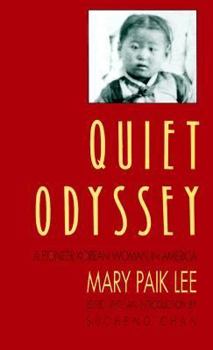Quiet Odyssey
Select Format
Select Condition 
Book Overview
Mary Paik Lee, born Paik Kuang Sun in 1900, left her native country in 1905, traveling with her parents as a political refugee after Japan imposed control over Korea at the close of the Russo-Japanese War. Her father labored in the sugar plantations of Hawaii for a year and a half before taking his family to California, where Mrs. Lee has lived ever since. Though her father knew the comforts enjoyed by the educated traditional elite in Korea, after emigration he and his family shared the poverty stricken existence endured by thousands of Asian immigrants in early twentieth century America. Mrs. Lee's parents earned their living as farm laborers, tenant farmers, cooks, and janitors, and the family always took in laundry. Her father tried mercury mining until his health gave out. In their turn, Mrs. Lee and her husband farmed, sold produce, and managed apartment buildings. The author is engagingly outspoken and is extremely observant of her social and natural surroundings. Recounted incidents take on memorable life, as do the sharply etched settings of California's agricultural and mining country. She tells of singular hardship surmounted with resilience and characteristic grace. During much of her life Asian Americans were not treated as full human beings, yet she kept a powerful vision of what the United States could be.
Format:Paperback
Language:English
ISBN:0295969695
ISBN13:9780295969695
Release Date:April 1990
Publisher:University of Washington Press
Length:264 Pages
Weight:0.84 lbs.
Dimensions:0.8" x 5.3" x 9.0"
Age Range:22 years and up
Grade Range:Postsecondary and higher
Customer Reviews
4 ratings
Excellent
Published by Thriftbooks.com User , 23 years ago
This is a well thought out, organized and very important historical document/autobiography.
GIves perspective on the lives we lead
Published by Thriftbooks.com User , 24 years ago
I was assigned Quiet Odyssey for an Asian American studies class, and I was riveted by the clean, simple prose. But the story is far from simple, I admire Mary Paik Lee for her incredible endurance and courage. As a second generation Asian American, my family's roots in the United States are relatively new, but now I realize, that it has been due to Asian Americans like Mary Paik Lee that allow me to lead and pursue the life I wish. Not only is Quiet Odyssey the story of her life, it is also the story of California. It's eye opening to see how much Los Angeles and the rest of California have changed since she first landed here. And lastly, Mary Paik Lee has some incredible spunk to do and say some of the things she did. Impressive.
Historical significance cannot be stressed enough! Read it!
Published by Thriftbooks.com User , 25 years ago
I read this book in highschool while living in in Seoul, Korea. I am a Korean-American woman and I found the information in this book to be _invaluable_. Unlike similar historical works such as John Okada's 'No-No Boy' or Sui Sin Far's 'Mrs. Spring Fragrance and Other Writings', this is pure autobiography (or ethnobiography if you want to be technical). I cannot believe how lucky we are as Americans to get a first-hand account of a Korean-American living in turn of the century America, when there were literally only a handful living in the country at the time. The 'memoirs' are not only highly satisfying in themselves, they serve as anchors to the past in which to begin tracing a discernable branch of Asian-American history. Adds perspective in which to view today's world of American race relations. I think this is necessary reading for anyone who is interested in race, American society, and/or history. Will also appeal to minority activists.
One of the best ethnic study books I've ever read
Published by Thriftbooks.com User , 25 years ago
I am a student from San Francisco State University and this is one of the books that I have to read for my Ethnic Studies Class. I really think this is a book made for student of Ethnic Studies and I strongly recommend this book to anyone who is interested in learning more about history of Asian American.





